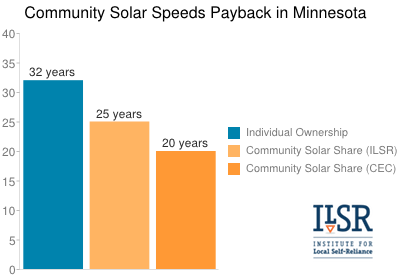As community solar grows in popularity, an innovative solar project by the Wright-Hennepin Cooperative Electric Association in Minnesota highlights the opportunity of merging local ownership with locally assembled solar panels.
Earlier this fall, this cooperative serving communities just north and west of the Twin Cities metropolitan area announced Minnesota’s first community solar project. The 40 kilowatt (kW) solar array will be located at the cooperative’s headquarters, with members allowed to purchase individual panels in the project for $869 per 180 Watt panel. In exchange, members will receive a credit on their bill equal to the electricity production of their portion of the 40 kW array.
 Participation in the community solar project lowers the payback period for solar, as compared to individual ownership, by 7-12 years.
Participation in the community solar project lowers the payback period for solar, as compared to individual ownership, by 7-12 years.
The project is organized by the Clean Energy Collective, a Colorado-based firm that has already built two community solar projects with rural electric cooperatives in that state and with plans to build several more. Their projects are noteworthy for being the only consistently replicable community solar model, as evidenced by their success. (for more on community solar projects, see our 2010 report).
Partnership is the key to CEC’s success, with the company providing cooperatives with “RemoteMeter” software allowing them to handle the accounting part of the community solar project (and a smartphone app to allow participants to track production). They also handle all of the project financing and development, with utilities having merely to market the program to their members and help oversee the project interconnection to their electric grid.
The community solar project provides a good deal for members, for three reasons. Most Minnesotans lack an appropriate, sunny space for a solar array (75% of people rent or have a roof that is unsuitable for solar). With Wright-Hennepin’s community solar array, participants can own a share of a local, centralized system that will be maintained by the cooperative, and still get their share of the electricity as though it were on their own rooftop.
The Clean Energy Collective has also negotiated a good rate for solar electricity, with participants receiving a credit of 12¢ per kWh generated by their panels, in comparison to the cooperative’s average residential retail rate of 9.3¢ per kWh.
The $4.83 per Watt cost for panels is also better than it looks, because the Wright-Hennepin project will use equipment from Minnesota’s tenKsolar. Using an innovative, low-cost reflector, the tenKsolar array boosts output by 25% over a traditional fixed tilt solar array, with an estimated output of around 291 kWh per year from each 180 W panel compared to 233 kWh from a traditional solar module. The local sourcing for equipment will also keep more of the cooperative members’ energy dollars in their community.
Investments in the Wright-Hennepin community solar project pay back in 20 years, according to the Clean Energy Collective (our own calculation was 25 years). Either way, it compares favorably to an individually-owned solar project, which would have a payback of 32 years or more. And the Clean Energy Collective warrants the project for 50 years, over which period a participant will have lifetime net savings of nearly $20,000.


